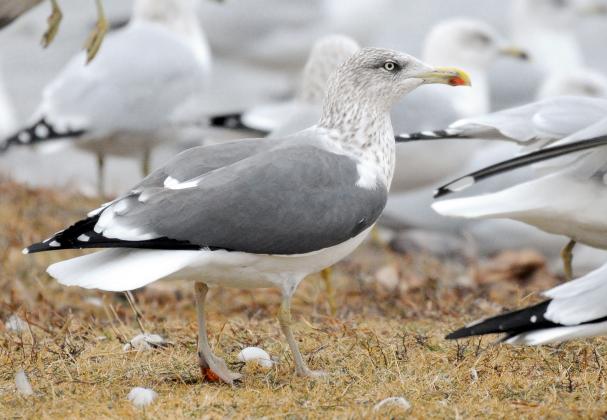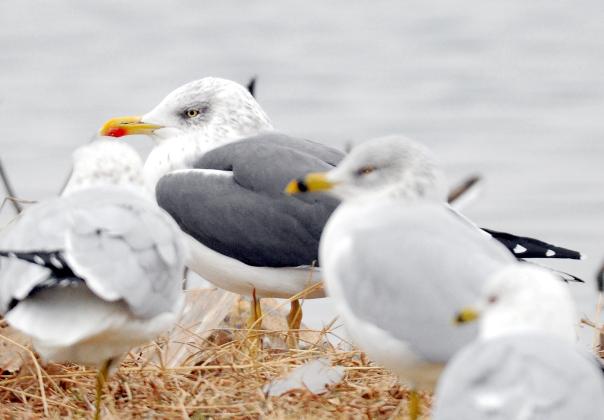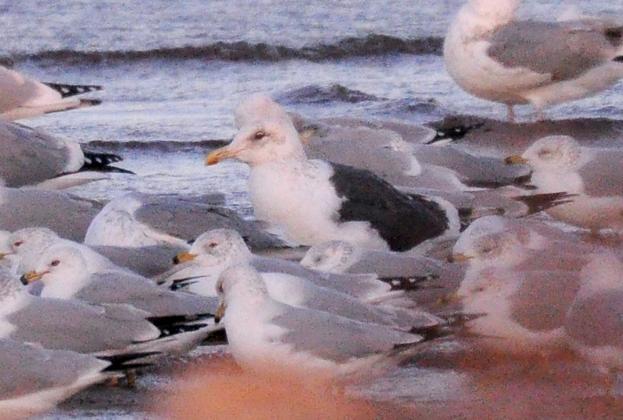I mentioned in last week’s column that a slaty-backed gull had been visiting Lake Hefner in Oklahoma City.
I also said that I would attempt to visit the lake and observe the bird and get some photos. Well, the good news is, I did locate and observe the bird, but I did not get many photos. And what I did get was from quite a distance.
The slaty-backed gull is an Asian species, and while in small numbers it regularly visits Alaska and sometimes the West Coast, it rarely strays into the interior of the United States. This is Oklahoma’s first known visit of this fairly large gull species.
I visited on Saturday, which was the last day the gull was seen at the lake. However, a birding expert happened upon the bird by chance Sunday at a former sod farm near Goldsby.
With the severe winter weather, most bird watchers are probably indoors, so the location of the bird is unknown at this time. It will be interesting if the bird is relocated after all this.
The slaty-backed gull is very similar in appearance to the lesser black-backed gull, which also has a slate-colored back, for the most part.
The lesser black-backed gull was once a rare sight in Oklahoma, but it has become much more common in the last couple of years. It is this week’s featured creature.
Although they are similar in appearance, the biggest difference between the two is that the lesser black-backed has yellow legs, while the slaty-backed has pink legs.
According to eBird, the lesser black-backed gull has not yet been reported in Comanche County, but it has been reported in areas surrounding the county. I can’t imagine that at least one hasn’t visited Lake Lawtonka.
The Vikings have landed!
The lesser black-backed gull, once a very rare stray to North America, has expanded greatly in numbers and distribution across the continent during the past 100 or so years, according to the National Audubon Society.
And ornithologists believe most of these birds are coming from Iceland.
Lesser black-backed gulls are common across Europe, and they have expanded westward.
The National Audubon Society indicates the increase of these birds in the United States is “undoubtedly” related to a growing population of the species in Iceland. Lesser black-backed gulls began nesting in Iceland in the 1920s and are now present by the thousands.
The bird recently began nesting in Greenland but has yet to nest in North America, where it is only a winter visitor. The Audubon Society says it is a fairly common visitor to the East Coast and west to the Great Lakes, but it is a less common visitor inland.
Now, my assumption is that the lesser black-backed gull is so named as there is a great black-backed gull, which is larger. I can’t confirm that, but it seems logical.
The great black-backed is the largest gull in the world and is an inhabitant of the northeastern United States.
Diet
I’m starting with the bird’s diet, as it may be surprising to some.
What does it eat? Just about everything. Its main diet consists of fish, insects, seeds, worms, eggs, carrion, garbage and even other birds.
While searching for information about this gull, I noticed that there are many videos of lesser black-backed gulls catching, killing and eating other birds, including pigeons, smaller gulls, ducklings and goslings.
It’s all quite brutal, but nature often is.
In the case of pigeons, the gulls capture and take the smaller birds to the water, where the gull has the advantage. It would then either drown them or sever their spines before eating them. Yikes!
Appearance
The black-backed gull is a big bird, larger than an American crow. IT ranges in length from 20 to 25 inches and has a wingspan of about 4 to 5 feet, according to the Cornell Lab of Ornithology.
They are dark gray on their backs and the backs of their wings. The term “black-backed” comes from the fact that there are many subspecies, some of which have very dark backs. However, the vast majority of birds that visit North America appear similar to the birds in my photos — with dark gray backs.
They have all-white heads during the breeding season, but winter birds have grayish spots and streaks on the necks and heads.
They have a dark, smudgy patch around the eye (photo), and a red spot on the lower mandible of the beak. Legs of adults are yellow or yellowish.
It is somewhat similar in appearance to the herring gull but slightly smaller. Also, its back is quite a bit darker than the herring’s, which is a lighter gray.
Juveniles are mottled in brown colors and have black beaks, and legs are paler yellow than adults.
Habitat
Beaches, coasts, lakes and lake edges, bays and garbage dumps.
Range
It is an uncommon visitor from about Colorado and states eastward.
Odds and ends
* If you would like to see a lesser black-backed gull, Lake Hefner in Oklahoma City during the winter is a good place to do so. While they were a rare sight there just a few years ago, it seems that there are about a dozen birds there at any given time now.
*According to the Cornell Lab of Ornithology, the oldest known lesser black-backed gull was a little over nine years old after it was identified by a band placed around its leg when young.
* Please don’t forget to check out my Randy’s Natural World YouTube channel, www.youtube.com/user/randyadventure. I’m making new videos as quickly as I can.
Editor’s note: Randy Mitchell is a freelance writer and photographer. He has been an avid birdwatcher, nature enthusiast and photographer for more than 40 years. Reach him at rnw@usa.com.




